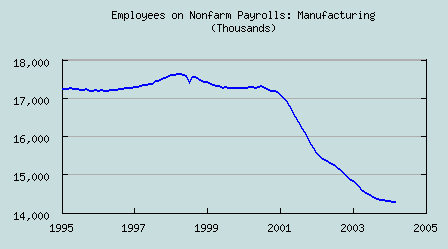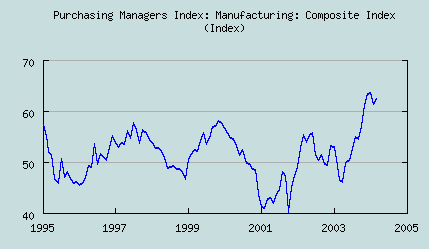How should the public, economists, politicians and workers measure the relative success and failure of a particular industry? By its profits? Its stock price? By its total employment? This may seem a rather elementary question, yet a proper and clear answer would go a long way in silencing what has been the loudest protectionist cry in recent memory. I am, of course, speaking of the manufacturing sector and its so called "crisis."
I have written elsewhere of the job losses that have occurred within manufacturing. These losses are the logical and beneficial outcome of increased worker productivity due to capital accumulation combined with the gains from world trade. The American population should welcome and encourage this trend. The cornucopia of goods that now confronts even the relatively poor in this country is astounding.
Yet the decision by most Americans to seek out the cheapest goods on the market with little or no empathy for the American manufacturer has created the most recent "crisis" to fill the newspapers. By buying the cheapest goods on the shelf (which in many cases emanate from China) the voters in the economic democracy have put pressure on manufacturers to cut costs and this happens, we are told, through mass layoffs. It seems we are witnessing the decline of the once mighty American manufacturing industry. But is a decrease in employment an accurate representation of an industry's health?
What plagues the economic pessimists, in general and specifically with regard to manufacturing, is the tendency to look only at the immediate effects. Furthermore, trade, free markets, etc. are examined from only one point of view, that is, from the observer who sees the layoffs, and not the production. The decline of total manufacturing employment is reported without any mention of output and productivity. Job losses are lamented while the ability to produce more manufactured goods with less labor is ignored.

Case in point was the April 2nd announcement by the Institute for Supply Management that their monthly index of manufacturing had risen for the month of March. This is the 10th consecutive month the index has shown growth in manufacturing, yet this report received scant mention in the nightly news or on the editorial pages of the major newspapers. Instead of celebrating that America's manufacturers are finally emerging from the most recent recession with strong signs of growth, tales of gloom and doom fill the air waves. The gains to consumers from less expensive goods are largely forgotten. So too are the productivity increases for producers who now need less labor to produce more goods. The few, visible and concentrated job losses are much more resonant and shocking than the widespread, subtle and diffused benefits of growth.
While the trend over the past fifty years has been for a gradual reduction in the number employed in manufacturing, both output and productivity have increased. The labor force of the economy is moving more and more toward services; that is, we are producing things in a way that doesn't break our backs. This does not mean that we will not have a manufacturing sector. Manufacturing today is as strong as ever—there simply aren't as many people needed to produce the increased amount of manufactured goods. In the May/June 2004 issue of Foreign Affairs, Daniel W. Drezner cites data that shows global employment in manufacturing decreasing by 11% between 1995 and 2002, all the while global manufacturing output increased by 30% during the same period. Put another way, not only did the United States experience a fall in manufacturing employment, so did the whole world, and as this occurred output managed to increase by 1/3. As Drezner argues, "If outsourcing were in fact the chief cause of manufacturing losses, one would expect corresponding increases in manufacturing employment in developing countries."
This brings up the question: Which is preferred—a healthy, productive manufacturing sector (that is, one that has shed excess labor)—or a bloated, inefficient industry that can't and doesn't compete in the global marketplace? China, for one, would be happy to take an even larger share of our manufacturing market.
My favorite protectionist, Pat Buchanan, had this to say in August, 2003: "Every month George Bush has been in office, America has lost manufacturing jobs. One in seven has vanished since his inauguration. In 1950, a third of our labor force was in manufacturing. Now, it is 12.5 percent. U.S. manufacturing is in a death spiral, and it is not a natural death. This is a homicide. Open-borders free trade is killing American manufacturing."
As Buchanan may or may not realize, manufacturing is not alone in its death at the hands of free trade. In the year 1900, roughly half of the American work force was employed in agriculture. One hundred years later that percentage had dropped (bled in Buchanan's words) down to 2%. Free trade, innovation and capital creation had obviated the need for 98% of the total work force. Farms today are big and highly technical. Imagine the tragedy if government had "saved" the farmers from losing their jobs 100 years ago.
It is safe to assume that our manufacturing sector would not be the rousing success it is today were there not the flexibility and freedom of the American labor pool to move into new and innovative sectors of the economy. Is the case of agriculture any different than that of manufacturing? Not in the slightest. Both sectors are absolutely necessary for the survival of the American economy and because of this, the invigorating forces of competition and free trade should be left free to benefit them.

While opponents are quick to blame the Chinese, Indians and the market mechanism for manufacturing's slow death, few recognize the structural reorganization that was necessary for manufactures to recover from the most recent recession. The Wall Street Journal comes close to the truth: "Manufacturing's resurgence is due in part to the depths to which it fell during the recession and weak recovery of 2001–2003 because of plunging capital spending, weak exports hampered by a strong dollar and Herculean efforts to reduce inventories. In the process, some three million factory jobs were wiped out." Today's manufacturers are recovering from a Hayekian hangover. Drunk on the cheap credit and easy money of the late 1990's, these past three years have proven tough, yet necessary.
The debate over trade and manufacturing has reached a critical point. History has proven that we can, and indeed usually do, kill the golden goose. The threats of protection emanating from Washington are very real and have the potential to upset an already fragile global economy. If we focus on employment, we lose sight of the subtle but very real benefits that commerce and free trade bring to a populace. Public policy should not be made based upon the personal circumstances of those who lose their jobs due to trade for the same reason that we don't let the victims of crime sentence their attackers. The impersonal forces of the price system and free market are indeed harsh, yet this is exactly their great strength. Free from the edicts of politicians and government rulers, the free market gives every man his equal due.

